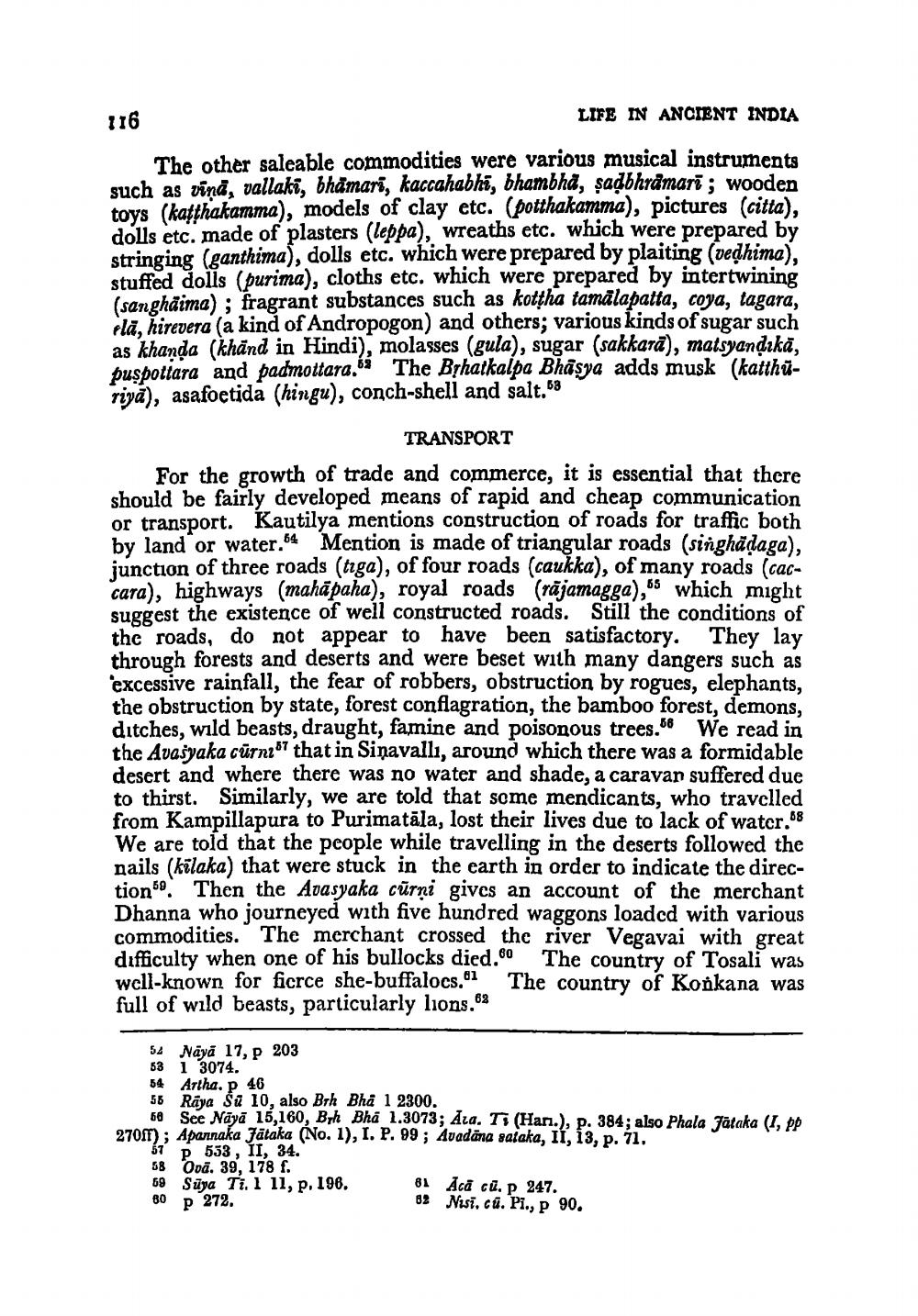________________
LIFE IN ANCIENT INDIA
116
The other saleable commodities were various musical instruments such as vina, vallaki, bhämari, kaccahabhi, bhambhd, sadbhrdmari; wooden toys (katthakamma), models of clay etc. (potthakamma), pictures (citta), dolls etc. made of plasters (leppa), wreaths etc. which were prepared by stringing (ganthima), dolls etc. which were prepared by plaiting (vedhima), stuffed dolls (purima), cloths etc. which were prepared by intertwining (sanghäima); fragrant substances such as kottha tamalapatta, coya, tagara, ela, hirevera (a kind of Andropogon) and others; various kinds of sugar such as khanda (khānd in Hindi), molasses (gula), sugar (sakkarā), matsyandıkā, busbotlara and padmottara. The Byhatkalpa Bhasya adds musk (katthüriya), asafoetida (hingu), conch-shell and salt.63
prepared by plaiti prepared by
anghaima); fragran: cloths etc. which
TRANSPORT
For the growth of trade and commerce, it is essential that there should be fairly developed means of rapid and cheap communication or transport. Kautilya mentions construction of roads for traffic both by land or water.64 Mention is made of triangular roads (singhädaga), junction of three roads (trga), of four roads (caukka), of many roads (caccara), highways (mahāpaha), royal roads (rājamagga)," which might suggest the existence of well constructed roads. Still the conditions of the roads, do not appear to have been satisfactory. They lay through forests and deserts and were beset with many dangers such as 'excessive rainfall, the fear of robbers, obstruction by rogues, elephants, the obstruction by state, forest conflagration, the bamboo forest, demons, ditches, wild beasts, draught, famine and poisonous trees. We read in the Avasyaka cūrn207 that in Siņavallı, around which there was a formidable desert and where there was no water and shade, a caravan suffered due to thirst. Similarly, we are told that some mendicants, who travelled from Kampillapura to Purimatāla, lost their lives due to lack of water.68 We are told that the people while travelling in the deserts followed the nails (kilaka) that were stuck in the earth in order to indicate the direction. Then the Avasyaka cūrni gives an account of the merchant Dhanna who journeyed with five hundred waggons loaded with various commodities. The merchant crossed the river Vegavai with great difficulty when one of his bullocks died. The country of Tosali was well-known for ficrce she-buffalocs. The country of Konkana was full of wild beasts, particularly lions.
54 Nāya 17, p 203 531 3074. 54 Attha, p 46 56 Raya Su 10, also Brh Bhi 1 2300.
66 See Nāyā 15,160, Byh Bha 1.3073; Ara. Ts (Han.), p. 384; also Phala Jataka (I, pp 2701); Apannaka Jataka (No. 1), I. P. 99 ; Avadäna salaka, II, 13, p. 71.
57 P 553, II, 34. 58 Odā. 39, 178 f. 69 Sūya Tí. I 11, p. 196.
81 Ācā cū. p 247. 80 P 272.
82 Nisi, cu. Pi., P 90.




